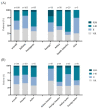Toxoplasma gondii Serotypes in Italian and Foreign Populations: A Cross-Sectional Study Using a Homemade ELISA Test
- PMID: 36013995
- PMCID: PMC9415598
- DOI: 10.3390/microorganisms10081577
Toxoplasma gondii Serotypes in Italian and Foreign Populations: A Cross-Sectional Study Using a Homemade ELISA Test
Abstract
Toxoplasma gondii is a protozoan parasite responsible for human toxoplasmosis. The three major clonal lineages and different recombinant strains of T. gondii have a varied global distribution. This study aimed at evaluating the epidemiological distribution of types II and I-III and recombinant or mixed T. gondii in Italians and foreigners residing in Italy, establishing an association between serotypes and demographic characteristics. We collected the sera of 188 subjects who had tested positive for specific T. gondii antibodies. The population was differentiated into groups based on sex, nationality, and place of birth (Italy, Africa, South America, Asia, or Europe (except Italy)). We then performed a homemade ELISA test that detected both the antibodies against the amino acid sequences of the three main genotype antigens (I-III) in human sera and discerned the T. gondii strains. Serotype II of T. gondii was the most prevalent in the Italian population, whereas type I-III was the most prevalent in the foreign group. Surprisingly, we observed a notable amount of recombinant or mixed serotypes in European and Italian subjects. Moreover, we showed a significant difference in the prevalence of T. gondii serotypes between men and women, Italians, and foreigners. This descriptive study is the first to investigate the epidemiological distribution of T. gondii serotypes in humans in Italy using a homemade ELISA. We considered this technique suitable for discriminating between serotypes II and I-III and, consequently, for an epidemiological study focusing on the observation of circulating T. gondii strains and clinical correlations.
Keywords: Italians; Toxoplasma gondii; epidemiology; migrants; serotype ELISA.
Conflict of interest statement
The authors declare no conflict of interest.
Figures



References
-
- Lorenzi H., Khan A., Behnke M.S., Namasivayam S., Swapna L.S., Hadjithomas M., Karamycheva S., Pinney D., Brunk B.P., Ajioka J.W., et al. Local Admixture of Amplified and Diversified Secreted Pathogenesis Determinants Shapes Mosaic Toxoplasma Gondii Genomes. Nat. Commun. 2016;7:10147. doi: 10.1038/ncomms10147. - DOI - PMC - PubMed
-
- Mercier A., Devillard S., Ngoubangoye B., Bonnabau H., Bañuls A.-L., Durand P., Salle B., Ajzenberg D., Dardé M.-L. Additional Haplogroups of Toxoplasma Gondii out of Africa: Population Structure and Mouse-Virulence of Strains from Gabon. PLoS Negl. Trop. Dis. 2010;4:e876. doi: 10.1371/journal.pntd.0000876. - DOI - PMC - PubMed
LinkOut - more resources
Full Text Sources

